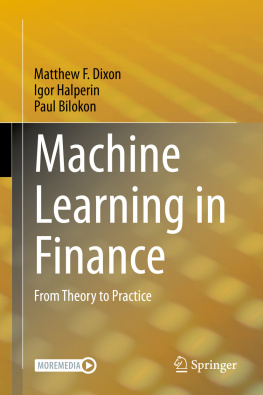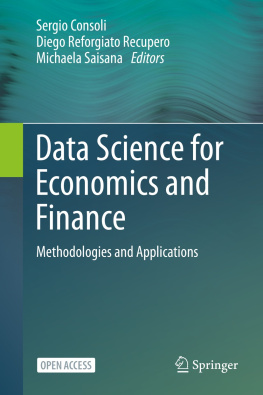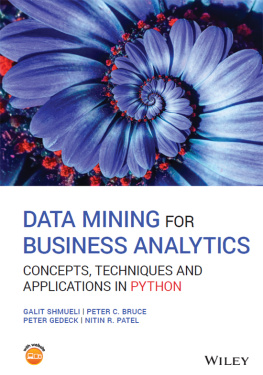Econometric Methods with Applications in Business and Economics
Econometric Methods with Applications in Business and Economics
Christiaan Heij
Paul de Boer
Philip Hans Franses
Teun Kloek
Herman K. van Dijk


Great Clarendon Street, Oxford OX2 6DP
Oxford University Press is a department of the University of Oxford.
It furthers the Universitys objective of excellence in research, scholarship,
and education by publishing worldwide in
Oxford New York
Auckland Cape Town Dar es Salaam Hong Kong Karachi
Kuala Lumpur Madrid Melbourne Mexico City Nairobi
New Delhi Shanghai Taipei Toronto
With offices in
Argentina Austria Brazil Chile Czech Republic France Greece
Guatemala Hungary Italy Japan Poland Portugal Singapore
South Korea Switzerland Thailand Turkey Ukraine Vietnam
Oxford is a registered trade mark of Oxford University Press
in the UK and in certain other countries
Published in the United States
by Oxford University Press Inc., New York
Christiaan Heij, Paul de Boer, Philip Hans Franses, Teun Kloek, and Herman K. van Dijk, 2004
The moral rights of the authors have been asserted
Database right Oxford University Press (maker)
First published 2004
All rights reserved. No part of this publication may be reproduced,
stored in a retrieval system, or transmitted, in any form or by any means,
without the prior permission in writing of Oxford University Press,
or as expressly permitted by law, or under terms agreed with the appropriate
reprographics rights organization. Enquiries concerning reproduction
outside the scope of the above should be sent to the Rights Department,
Oxford University Press, at the address above
You must not circulate this book in any other binding or cover
and you must impose the same condition on any acquirer
British Library Cataloguing in Publication Data
Data available
Library of Congress Cataloguing in Publication Data
Data available
Typeset by SPI Publisher Services, Pondicherry, India
Printed in Great Britain
on acid-free paper by Antony Rowe Ltd, Chippenham, Wiltshire
ISBN 0199268010
3 5 7 9 10 8 6 4 2
Preface
Econometric models and methods are applied in the daily practice of virtually all disciplines in business and economics like finance, marketing, microeconomics, and macroeconomics. This book is meant for anyone interested in obtaining a solid understanding and active working knowledge of this field. The book provides the reader both with the required insight in econometric methods and with the practical training needed for successful applications. The guiding principle of the book is to stimulate the reader to work actively on examples and exercises, so that econometrics is learnt the way it works in practicethat is, practical methods for solving questions in business and economics, based on a solid understanding of the underlying methods. In this way the reader gets trained to make the proper decisions in econometric modelling.
This book has grown out of half a century of experience in teaching undergraduate econometrics at the Econometric Institute in Rotterdam. With the support of Jan Tinbergen, Henri Theil founded the institute in 1956 and he developed Econometrics into a full-blown academic programme. Originally, econometrics was mostly concerned with national and international macroeconomic policy; the required computing power to estimate econometric models was expensive and scarcely available, so that econometrics was almost exclusively applied in public (statistical) agencies. Much has changed, and nowadays econometrics finds widespread application in a rich variety of fields. The two major causes of this increased role of econometrics are the information explosion in business and economics (with large data setsfor instance, in finance and marketing) and the enormous growth in cheap computing power and user-friendly software for a wide range of econometric methods.
This development is reflected in the book, as it presents econometric methods as a collection of very useful tools to address issues in a wide range of application areas. First of all, students should learn the essentials of econometrics in a rigorous way, as this forms the indispensable basis for all valid practical work. These essentials are treated in (on time series data with applications in finance and international economics). The Introduction provides more information on the motivation and contents of the book, together with advice for students and instructors, and the Guide to the Book explains the structure and use of the book.
We thank our students, who always stimulate our enthusiasm to teach and who make us feel proud by their achievements in their later careers in econometrics, economics, and business management. We also thank both current and former members of the Econometric Institute in Rotterdam who have inspired our econometric work.
Several people helped us in the process of writing the book and the solutions manual. First of all we should mention our colleague Zsolt Sandor and our (current and former) Ph.D. students Charles Bos, Lennart Hoogerheide, Rutger van Oest, and Bjrn Vroomen, who all contributed substantially in producing the solutions manual. Further we thank our (current and former) colleagues at the Econometric Institute, Bas Donkers, Rinse Harkema, Johan Kaashoek, Frank Kleibergen, Richard Kleijn, Peter Kooiman, Marius Ooms, and Peter Schotman. We were assisted by our (former) students Arjan van Dijk, Alex Hoogendoorn, and Jesse de Klerk, and we obtained very helpful feedback from our students, in particular from Simone Jansen, Martijn de Jong, Marille Non, Arnoud Pijls, and Gerard Voskuil. Special thanks are for Aletta Henderiks, who never lost her courage in giving us the necessary secretarial support in processing the manuscript. Finally we wish to thank the delegates and staff of Oxford University Press for their assistance, in particular Andrew Schuller, Arthur Attwell, and Hilary Walford.
Christiaan Heij, Paul de Boer, Philip Hans Franses, Teun Kloek, Herman K. van Dijk
Rotterdam, 2004

From left to right: Christiaan Heij, Paul de Boer, Philip Hans Franses, Teun Kloek, and Herman K. van Dijk
Contents
Detailed Contents
List of Exhibits
Abbreviations
Apart from abbreviations that are common in econometrics, the list also contains the abbreviations (in italics) used to denote the data sets of examples and exercises, but not the abbreviations used to denote the variables in these data sets (see for the meaning of the abbreviated variable names).
2SLS | two-stage least squares |
3SLS | three-stage least squares |
ACF | autocorrelation function |
ADF | augmented DickeyFuller |
ADL | autoregressive distributed lag |
AIC | Akaike information criterion |
AR | autoregressive |
ARCH | autoregressive conditional heteroskedasticity |
Next page










